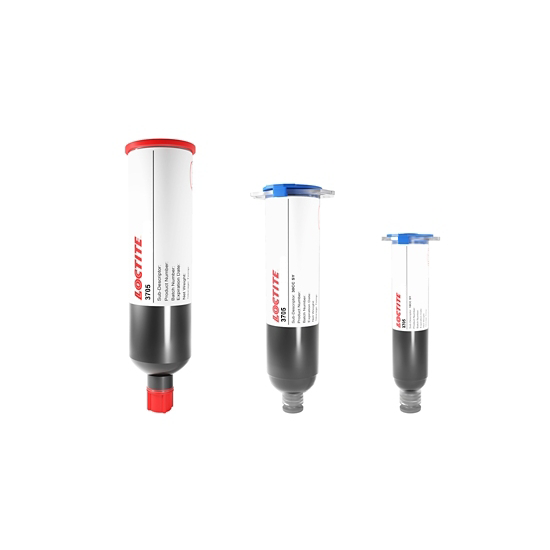LOCTITE 3705
Harmonization Code : 3506.10.00.00 | Prepared glues and other prepared adhesives, not elsewhere specified or included; products suitable for use as glues or adhesives, put up for retail sale as glues or adhesives, not exceeding a net weight of 1 kg
Main features
- UV Cure
- One component
- Edgebond
Product Description
LOCTITE 3705 UV cure adhesive is designed for high throughput assembly operations. Its thixotropic nature reduced migration of liquid product after application to substrate.
LOCTITE 3705 cures fast and does not require any post curing steps. It is thixotropic with medium viscosity and exhibits good adhesion on a variety of substrates. This edgebonder is typically used to bond electronic components on a PCB.
UV Cure:
- 80 seconds @ 30 mW/cm²
Technical Specifications
| General Properties | |||||||
| Specific Gravity Specific Gravity Specific gravity (SG) is the ratio of the density of a substance to the density of a reference substance; equivalently, it is the ratio of the mass of a substance to the mass of a reference substance for the same given volume. For liquids, the reference substance is almost always water (1), while for gases, it is air (1.18) at room temperature. Specific gravity is unitless. | 1.1 | ||||||
| Physical Properties | |||||||
| Viscosity Viscosity Viscosity is a measurement of a fluid’s resistance to flow. Viscosity is commonly measured in centiPoise (cP). One cP is defined as the viscosity of water and all other viscosities are derived from this base. MPa is another common unit with a 1:1 conversion to cP. A product like honey would have a much higher viscosity -around 10,000 cPs- compared to water. As a result, honey would flow much slower out of a tipped glass than water would. The viscosity of a material can be decreased with an increase in temperature in order to better suit an application | 44,000 mPa.s | ||||||
| Mechanical Properties | |||||||
| Elongation Elongation Elongation is the process of lengthening something. It is a percentage that measures the initial, unstressed, length compared to the length of the material right before it breaks. It is commonly referred to as Ultimate Elongation or Tensile Elongation at break. | 186 % | ||||||
| |||||||
| Thermal Properties | |||||||
| |||||||
| Glass Transition Temperature (Tg) Glass Transition Temperature (Tg) The glass transition temperature for organic adhesives is a temperature region where the polymers change from glassy and brittle to soft and rubbery. Increasing the temperature further continues the softening process as the viscosity drops too. Temperatures between the glass transition temperature and below the decomposition point of the adhesive are the best region for bonding. The glass-transition temperature Tg of a material characterizes the range of temperatures over which this glass transition occurs. | -39 °C | ||||||
| Thermal Conductivity Thermal Conductivity Thermal conductivity describes the ability of a material to conduct heat. It is required by power packages in order to dissipate heat and maintain stable electrical performance. Thermal conductivity units are [W/(m K)] in the SI system and [Btu/(hr ft °F)] in the Imperial system. | 0.17 W/m.K | ||||||
Additional Information
UV/Light Cure Strengths
- One component
- No solvents
- Very fast room temperature cure
- Cure on demand-facilitates parts alignment
- Less equipment space and energy
- Fast through put-low WIP
UV/Light Cure Limitations
- Sensitive to light-requires special space lighting
- Oxygen inhibits cure
- Line of sight cure- shadowed areas require secondary cure
- High CTE- fillers used to lower CTE block UV/light




